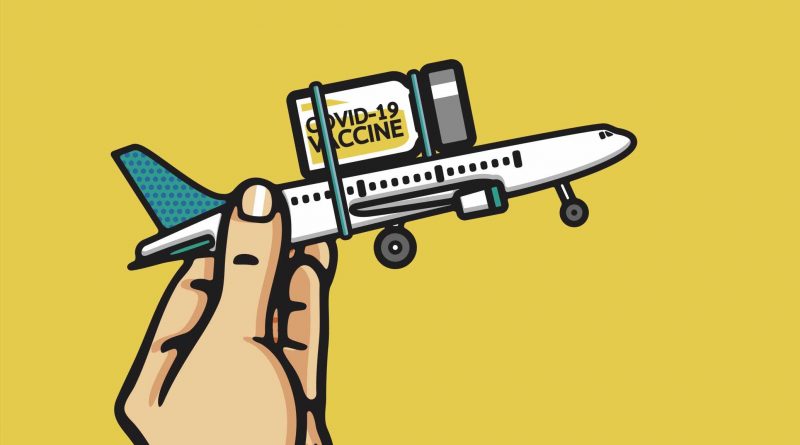A Global Search for Vaccines Fuels a Different Kind of Tourism
© Illustration by Shutterstock
A Global Search for Vaccines Fuels a Different Kind of Tourism
Illustration by Shutterstock Despite the ethical conundrums around vaccine tourism, the chance to skip the line has a powerful pull.
Load Error
The traffic filling those planes is largely travelers headed to (and returning from) the United States, and it’s a phenomenon that others are noticing, too, on routes across Mexico and Latin America. Reuters reported in early May that fares on flights to the United States from Mexico had increased by 30 to 40 percent compared to mid-March; American Airlines has reported an increased demand for flights to the United States from Colombia, Ecuador, and Mexico and has responded by increasing capacity.
Most airline and government officials keep their explanations for the increased flight capacity focused on the raw numbers: high demand justifies additional flights. There is, however, evidence—some anecdotal and some based in data—that the increase has been fueled, at least in part, by a new twist in medical tourism, as citizens of Mexico and other countries in Latin America head to the United States in search of COVID-19 vaccines.
Discussions among both American expats in Mérida, where I live, and Mexican residents frequently turn to the topic of vaccine runs and questions like,“Does it make more sense to fly direct to Houston or take a three-hour bus to Cancun and catch a cheaper flight to Dallas?” Or “How does the process for getting an appointment differ in Texas versus California?”
Full disclosure—as a U.S. citizen living in Mérida, I had debated traveling to the United States to get vaccinated. Now that I am scheduled to receive the two-dose Pfizer vaccine in Mexico, I will get it here.
U.S. destinations courting vaccine tourists
Some U.S. cities and states are going beyond tacitly allowing travelers to get vaccinated and are actively encouraging the vaccine-tourism trend. In April, Alaska announced that come June it would provide free COVID vaccines upon arrival to any visitor landing at one of the state’s four major airports. After New York State announced that it was dropping its residency requirement to receive the vaccine at the beginning of May, New York City Mayor Bill de Blasio introduced a plan for pop-up vaccination sites at tourist spots, including Central Park, the High Line, and the Brooklyn Bridge.
Meanwhile, Mexico’s vaccine rollout has been slow, though recently the pace has improved. According to the country’s original schedule, all interested residents from 50 to 60 years old were supposed to have received their first dose by April 30. In Mérida, the first members of that age group will begin to receive the vaccine on May 25. To date, 15 percent of Mexican residents have received at least one jab, and just over 9 percent have been fully vaccinated, according to Johns Hopkins vaccine tracker.
Mexican residents are among those to have flown to the U.S. in the highest numbers, with the Mexico City newspaper La Jornada estimating that 400,000 Mexican citizens have already been vaccinated in the United States, with some 1.2 million planning to over the course of the year.
There are about 20 U.S. states that have no residency requirement to receive the vaccine. Many states that require residency have loopholes for those who work or study in the state or own property there. Even in those states with residency requirements, sometimes the state or jurisdictions within the state become known for not asking too many questions or requiring much, if any, documentation to prove it.
Video: Europe may soon open travel to vaccinated Americans (ABC News)
Vaccine Watch: Incentivizing the vaccine
ABC News
Idaho mother deemed unfit to stand trial
ABC News
Indigenous student’s disappearance part of epidemic of missing native women: Part 1
ABC News
Chad Daybell and Lori Vallow appear in court for murder charges
ABC News
On Location: May 27, 2021
ABC News
Fallen Capitol officer’s mother lobbies GOP senators on Jan. 6 commission
ABC News
US warns of further action against Ethiopia, Eritrea
ABC News
New details after gunman opens fire at California transit rail yard
ABC News
Senate Republicans unveil counteroffer on Biden infrastructure plan
ABC News
$67,000 reward for help finding shooter of 3-year-old
ABC News
Woman sped through vaccination tent in protest, authorities say
ABC News
Inspirational UPS employee shares message
ABC News
States offer major incentives to increase vaccination rates
ABC News
Accused killer makes stunning claim in Mollie Tibbetts trial
ABC News
Vaccine Watch: Incentivizing the vaccine
Vaccine Watch: Incentivizing the vaccine
ABC News
Idaho mother deemed unfit to stand trial
Idaho mother deemed unfit to stand trial
ABC News
Indigenous student’s disappearance part of epidemic of missing native women: Part 1
Indigenous student’s disappearance part of epidemic of missing native women: Part 1
ABC News
Jorge, a 32-year-old entrepreneur who is a Mexican citizen living in Mérida, traveled to Orlando in search of the Johnson & Johnson vaccine. Asked why he chose to travel to the U.S., Jorge replied, simply: “Well, that’s where the vaccines are.” His experience was positive. “They are taking advantage of medical tourism to reactivate their economy,” he says. “Everyone was friendly and the entire operation was well run.”
(Because of the ethical and legal questions around certain aspects of vaccine tourism, AFAR offered not to disclose the full names or identifying details of sources who shared their vaccine tourism experiences for this story.)
Dr. Carlos Cabrera, a doctor based in Mérida who works with the U.S. consulate and has many American and Mexican patients, says that most of his American patients are choosing to wait in Mexico. “I would say that more than 70 percent of my expat patients have decided to get it here,” he says. “Traveling presents risks—on the way to the U.S., before receiving any vaccine, patients don’t have any immunity. Then on the return trip, unless you wait for 10 days, you only have part of the protection that the vaccine offers.”
Cabrera does, however, know many Mexicans who made the trip, including doctors in private practice who were not included with the frontline hospital workers when they were offered the vaccine in Mexico. “It’s very accessible and while some places require an ID or an appointment,” he says, “others do not.”
Vaccine tourism around the world
The United States isn’t the only country encouraging vaccine tourism. Tour operators are also offering trips to Moscow to receive the Sputnik vaccine and to Dubai to receive the Chinese Sinopharm shots. While Latin America is the major international market for vaccine tourists to the United States, it is not the only one. Even Europeans are considering a trip to the U.S. (once they can legally enter, as a ban on most travel from Europe remains in place).
“I still can’t believe the U.S. has done a better job with this than mainland Europe,” says Shandana, an American writer based in Berlin who may travel to her home state of Michigan in search of the vaccine. “I am flabbergasted that I am still on a waiting list with my asthma.”
There is also demand from Canada where, as of press time, only 5 percent of the population had been fully vaccinated compared to 40 percent in the United States. Even in countries as distant as Thailand, the travel agency Unithai Trip is offering trips to the United States for up to $6,400 that include the option to receive either the Johnson & Johnson or the two-dose Pfizer vaccine.
The ethical and public health concerns surrounding vaccine tourism
This use of the vaccine as a lure for tourists has some problematic implications. First, its very existence depends on an inequitable distribution of the vaccine. The enormous vaccine purchases by some wealthy nations have created a scarcity mindset that fuels demand for the vaccine. According to one measure, Canada will eventually have enough vaccines to inoculate its population five times over.
“Vaccine tourism favors those who have the means to travel internationally and is perhaps the least efficient means of vaccinating the world,” says Dr. Michael Sinha, adjunct faculty member at Northeastern University School of Law and visiting scholar at the NUSL Center for Health Policy and Law. “It also puts many people at risk. There is a very real risk that individuals will contract COVID-19 prior to being fully immunized, or worse, may be asymptomatic carriers that spread the infection in international airports and aboard airplanes prior to arriving in the United States.”
A logistically easier solution than having people travel to the United States for the vaccine would be to send the vaccine to them. It’s one that the Biden administration is pursuing in part. President Biden recently announced that an additional 20 million doses of vaccines would be sent by the U.S. to other countries, on top of an earlier pledge of 60 million doses.
“We should be donating our excess vaccine doses to COVAX now to immediately vaccinate all health care workers and high-risk individuals across the world,” Sinha says.
Despite the ethical conundrums around vaccine tourism, the chance to skip the line has a powerful pull, even as it continues to separate the haves from the have-nots. After a year-plus of lockdown and fear, FOMO is real.
“It was difficult looking at the Instagram posts and seeing friends’ celebratory ones as they received their vaccines and knowing I still had a long wait,” says Laura, an American artist living in Mérida. She decided to instead book a flight to Texas, where she would also have more freedom to choose the particular vaccine she wanted.
>> Next: The Ethics of Vaccinated Travel
Source: Read Full Article



















